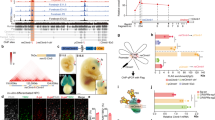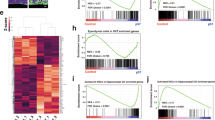Abstract
In the developing CNS, subtypes of neurons and glial cells are generated according to a schedule that is defined by cell-intrinsic mechanisms that function at the progenitor-cell level. However, no critical molecular switch for the temporal specification of CNS progenitor cells has been identified. We found that chicken ovalbumin upstream promoter-transcription factor I and II (Coup-tfI and Coup-tfII, also known as Nr2f1 and Nr2f2) are required for the temporal specification of neural stem/progenitor cells (NSPCs), including their acquisition of gliogenic competence, as demonstrated by their responsiveness to gliogenic cytokines. COUP-TFI and II are transiently co-expressed in the ventricular zone of the early embryonic CNS. The double knockdown of Coup-tfI/II in embryonic stem cell (ESC)-derived NSPCs and the developing mouse forebrain caused sustained neurogenesis and the prolonged generation of early-born neurons. These findings reveal a part of the timer mechanisms for generating diverse types of neurons and glial cells during CNS development.
This is a preview of subscription content, access via your institution
Access options
Subscribe to this journal
Receive 12 print issues and online access
$209.00 per year
only $17.42 per issue
Buy this article
- Purchase on Springer Link
- Instant access to full article PDF
Prices may be subject to local taxes which are calculated during checkout







Similar content being viewed by others
References
Temple, S. The development of neural stem cells. Nature 414, 112–117 (2001).
Miller, F.D. & Gauthier, A.S. Timing is everything: making neurons versus glia in the developing cortex. Neuron 54, 357–369 (2007).
Shen, Q. et al. The timing of cortical neurogenesis is encoded within lineages of individual progenitor cells. Nat. Neurosci. 9, 743–751 (2006).
Koblar, S.A. et al. Neural precursor differentiation into astrocytes requires signaling through the leukemia inhibitory factor receptor. Proc. Natl. Acad. Sci. USA 95, 3178–3181 (1998).
Nakashima, K. et al. Developmental requirement of gp130 signaling in neuronal survival and astrocyte differentiation. J. Neurosci. 19, 5429–5434 (1999).
Gross, R.E. et al. Bone morphogenetic proteins promote astroglial lineage commitment by mammalian subventricular zone progenitor cells. Neuron 17, 595–606 (1996).
Nakashima, K. et al. BMP2-mediated alteration in the developmental pathway of fetal mouse brain cells from neurogenesis to astrocytogenesis. Proc. Natl. Acad. Sci. USA 98, 5868–5873 (2001).
Grandbarbe, L. et al. Delta-Notch signaling controls the generation of neurons/glia from neural stem cells in a stepwise process. Development 130, 1391–1402 (2003).
Nakashima, K. et al. Synergistic signaling in fetal brain by STAT3-Smad1 complex bridged by p300. Science 284, 479–482 (1999).
Ge, W. et al. Notch signaling promotes astrogliogenesis via direct CSL-mediated glial gene activation. J. Neurosci. Res. 69, 848–860 (2002).
Sun, Y. et al. Neurogenin promotes neurogenesis and inhibits glial differentiation by independent mechanisms. Cell 104, 365–376 (2001).
Tomita, K., Moriyoshi, K., Nakanishi, S., Guillemot, F. & Kageyama, R. Mammalian achaete-scute and atonal homologs regulate neuronal versus glial fate determination in the central nervous system. EMBO J. 19, 5460–5472 (2000).
Nieto, M., Schuurmans, C., Britz, O. & Guillemot, F. Neural bHLH genes control the neuronal versus glial fate decision in cortical progenitors. Neuron 29, 401–413 (2001).
Gauthier, A.S. et al. Control of CNS cell-fate decisions by SHP-2 and its dysregulation in Noonan syndrome. Neuron 54, 245–262 (2007).
Schmid, R.S. et al. Neuregulin 1-erbB2 signaling is required for the establishment of radial glia and their transformation into astrocytes in cerebral cortex. Proc. Natl. Acad. Sci. USA 100, 4251–4256 (2003).
Sardi, S.P., Murtie, J., Koirala, S., Patten, B.A. & Corfas, G. Presenilin-dependent ErbB4 nuclear signaling regulates the timing of astrogenesis in the developing brain. Cell 127, 185–197 (2006).
Song, M.R. & Ghosh, A. FGF2-induced chromatin remodeling regulates CNTF-mediated gene expression and astrocyte differentiation. Nat. Neurosci. 7, 229–235 (2004).
Takizawa, T. et al. DNA methylation is a critical cell-intrinsic determinant of astrocyte differentiation in the fetal brain. Dev. Cell 1, 749–758 (2001).
Matsumoto, S. et al. Brg1 is required for murine neural stem cell maintenance and gliogenesis. Dev. Biol. 289, 372–383 (2006).
Stolt, C.C. et al. The Sox9 transcription factor determines glial fate choice in the developing spinal cord. Genes Dev. 17, 1677–1689 (2003).
Deneen, B. et al. The transcription factor NFIA controls the onset of gliogenesis in the developing spinal cord. Neuron 52, 953–968 (2006).
Hanashima, C., Li, S.C., Shen, L., Lai, E. & Fishell, G. Foxg1 suppresses early cortical cell fate. Science 303, 56–59 (2004).
Jacob, J. et al. Transcriptional repression coordinates the temporal switch from motor to serotonergic neurogenesis. Nat. Neurosci. 10, 1433–1439 (2007).
Park, J.I., Tsai, S.Y. & Tsai, M.J. Molecular mechanism of chicken ovalbumin upstream promoter-transcription factor (COUP-TF) actions. Keio J. Med. 52, 174–181 (2003).
Tripodi, M., Filosa, A., Armentano, M. & Studer, M. The COUP-TF nuclear receptors regulate cell migration in the mammalian basal forebrain. Development 131, 6119–6129 (2004).
Armentano, M., Filosa, A., Andolfi, G. & Studer, M. COUP-TFI is required for the formation of commissural projections in the forebrain by regulating axonal growth. Development 133, 4151–4162 (2006).
Armentano, M. et al. COUP-TFI regulates the balance of cortical patterning between frontal/motor and sensory areas. Nat. Neurosci. 10, 1277–1286 (2007).
Reynolds, B.A. & Weiss, S. Generation of neurons and astrocytes from isolated cells of the adult mammalian central nervous system. Science 255, 1707–1710 (1992).
Surani, M.A., Hayashi, K. & Hajkova, P. Genetic and epigenetic regulators of pluripotency. Cell 128, 747–762 (2007).
Qiu, Y. et al. Spatiotemporal expression patterns of chicken ovalbumin upstream promoter-transcription factors in the developing mouse central nervous system: evidence for a role in segmental patterning of the diencephalon. Proc. Natl. Acad. Sci. USA 91, 4451–4455 (1994).
Tsai, S.Y. & Tsai, M.J. Chick ovalbumin upstream promoter-transcription factors (COUP-TFs): coming of age. Endocr. Rev. 18, 229–240 (1997).
Mizutani, K., Yoon, K., Dang, L., Tokunaga, A. & Gaiano, N. Differential Notch signaling distinguishes neural stem cells from intermediate progenitors. Nature 449, 351–355 (2007).
Bonni, A. et al. Regulation of gliogenesis in the central nervous system by the JAK-STAT signaling pathway. Science 278, 477–483 (1997).
Stenman, J., Toresson, H. & Campbell, K. Identification of two distinct progenitor populations in the lateral ganglionic eminence: implications for striatal and olfactory bulb neurogenesis. J. Neurosci. 23, 167–174 (2003).
Wang, H.F. & Liu, F.C. Developmental restriction of the LIM homeodomain transcription factor Islet-1 expression to cholinergic neurons in the rat striatum. Neuroscience 103, 999–1016 (2001).
Jessell, T.M. Neuronal specification in the spinal cord: inductive signals and transcriptional codes. Nat. Rev. Genet. 1, 20–29 (2000).
Petryniak, M.A., Potter, G.B., Rowitch, D.H. & Rubenstein, J.L. Dlx1 and Dlx2 control neuronal versus oligodendroglial cell fate acquisition in the developing forebrain. Neuron 55, 417–433 (2007).
Olsson, M., Bjorklund, A. & Campbell, K. Early specification of striatal projection neurons and interneuronal subtypes in the lateral and medial ganglionic eminence. Neuroscience 84, 867–876 (1998).
Hevner, R.F. et al. Beyond laminar fate: toward a molecular classification of cortical projection/pyramidal neurons. Dev. Neurosci. 25, 139–151 (2003).
Pereira, F.A., Tsai, M.J. & Tsai, S.Y. COUP-TF orphan nuclear receptors in development and differentiation. Cell. Mol. Life Sci. 57, 1388–1398 (2000).
Bailey, P., Sartorelli, V., Hamamori, Y. & Muscat, G.E. The orphan nuclear receptor, COUP-TF II, inhibits myogenesis by post-transcriptional regulation of MyoD function: COUP-TF II directly interacts with p300 and myoD. Nucleic Acids Res. 26, 5501–5510 (1998).
Isshiki, T., Pearson, B., Holbrook, S. & Doe, C.Q. Drosophila neuroblasts sequentially express transcription factors which specify the temporal identity of their neuronal progeny. Cell 106, 511–521 (2001).
Kanai, M.I., Okabe, M. & Hiromi, Y. Seven-up controls switching of transcription factors that specify temporal identities of Drosophila neuroblasts. Dev. Cell 8, 203–213 (2005).
Egger, B., Chell, J.M. & Brand, A.H. Insights into neural stem cell biology from flies. Phil. Trans. R. Soc. Lond. B 363, 39–56 (2008).
Udolph, G., Rath, P. & Chia, W. A requirement for Notch in the genesis of a subset of glial cells in the Drosophila embryonic central nervous system which arise through asymmetric divisions. Development 128, 1457–1466 (2001).
Okada, Y., Shimazaki, T., Sobue, G. & Okano, H. Retinoic-acid concentration–dependent acquisition of neural cell identity during in vitro differentiation of mouse embryonic stem cells. Dev. Biol. 275, 124–142 (2004).
Shimazaki, T., Shingo, T. & Weiss, S. The ciliary neurotrophic factor/leukemia inhibitory factor/gp130 receptor complex operates in the maintenance of mammalian forebrain neural stem cells. J. Neurosci. 21, 7642–7653 (2001).
Miyoshi, H., Blomer, U., Takahashi, M., Gage, F.H. & Verma, I.M. Development of a self-inactivating lentivirus vector. J. Virol. 72, 8150–8157 (1998).
Jiang, X., Norman, M., Roth, L. & Li, X. Protein-DNA array-based identification of transcription factor activities regulated by interaction with the glucocorticoid receptor. J. Biol. Chem. 279, 38480–38485 (2004).
Acknowledgements
We are grateful to H. Miyoshi (Riken BioResource Center) for the lentivirus constructs, R.F. Hevner (University of Washington) for the antibody to Tbr1, S. Mitani (Tokyo Women's Medical University) for the antibody to GFP (mFX73) and K. Shimamura (Kumamoto University) for the Vp16 and Drosophila engrailed constructs. We also thank the members of the Okano laboratory for discussion, technical advice and/or critical reading of the manuscript. This study was supported by Core Research for Evolutional Science Technology/Solution-Oriented Research for Science and Technology–Japan Science and Technology Agency (H.O.), grants-in-aid for scientific research from the Ministry of Education, Culture, Sports, Science and Technology (MEXT) in Japan (T.S. and H.O.), a grant-in-aid from the 21st Century Center Of Excellence program of MEXT to Keio University, a Keio University grant-in-aid for encouragement of young medical scientists (H.N.), and a grant-in-aid for Japan Society for the Promotion of Science Fellows (H.N.).
Author information
Authors and Affiliations
Contributions
All experiments were designed by T.S. and H.N. T.S. guided the experimental processes. Most of the experiments and data analyses were carried out by H.N. Some parts of the in vitro culture assay and immunostaining were performed by S.N. S.N. also assisted with all the experiments. The project was supervised by T.S. and H.O.
Corresponding authors
Supplementary information
Supplementary Text and Figures
Supplementary Figures 1–8, Supplementary Tables 1 and 2, and Supplementary Methods (PDF 907 kb)
Supplementary Movie 1
Ectopically induced Tbr1-positive neurons by high-dose knockdown lentivirus infection showed abnormal multipolar morphology. Three-dimensional video image corresponding to Supplementary Fig. 6c. (MOV 8726 kb)
Rights and permissions
About this article
Cite this article
Naka, H., Nakamura, S., Shimazaki, T. et al. Requirement for COUP-TFI and II in the temporal specification of neural stem cells in CNS development. Nat Neurosci 11, 1014–1023 (2008). https://doi.org/10.1038/nn.2168
Received:
Accepted:
Published:
Issue Date:
DOI: https://doi.org/10.1038/nn.2168
This article is cited by
-
Spontaneously evolved progenitor niches escape Yap oncogene addiction in advanced pancreatic ductal adenocarcinomas
Nature Communications (2023)
-
Multiomics analysis identifies novel facilitators of human dopaminergic neuron differentiation
EMBO Reports (2023)
-
A Spacetime Odyssey of Neural Progenitors to Generate Neuronal Diversity
Neuroscience Bulletin (2023)
-
A comprehensive temporal patterning gene network in Drosophila medulla neuroblasts revealed by single-cell RNA sequencing
Nature Communications (2022)
-
Multi-species single-cell transcriptomic analysis of ocular compartment regulons
Nature Communications (2021)



